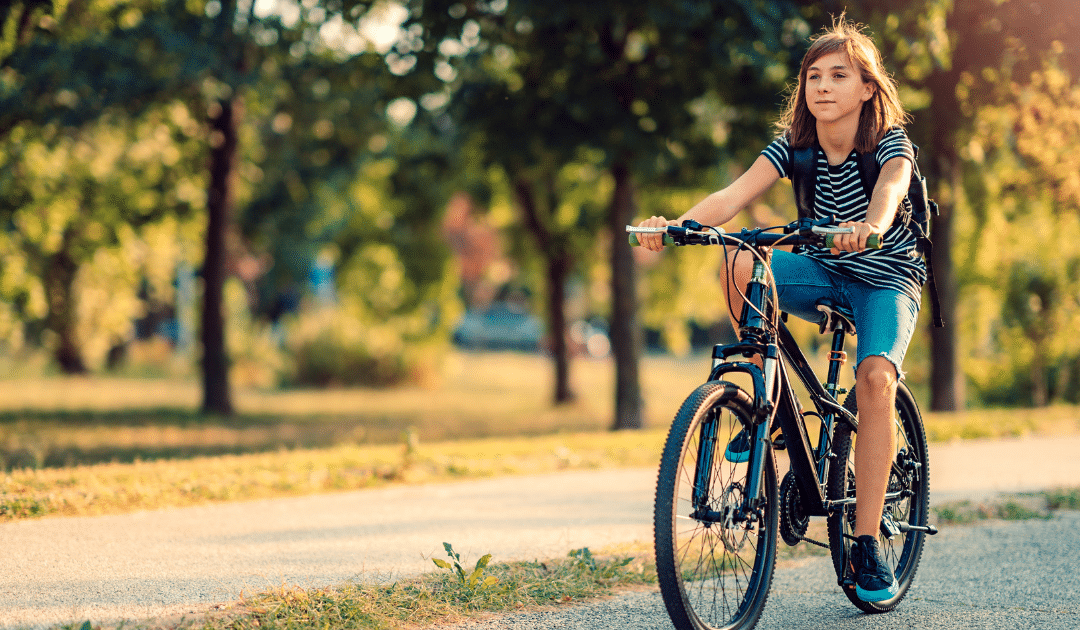Letting go is one of the hardest things we can do as parents. After all, we want to be there every step of the way—and that includes making sure our children get safely to school and home again.
But there comes a time when we step back, and send them on their way with pride (and just a little anxiety). How do we know when the right time is? Here’s some guidance on determining when and how to let your child walk or bike to school alone.
First, let’s remember the benefits.
Walking or biking alone to school is a milestone in growing up. It’s good for your child and it’s good for you. Here’s why.
-
- It’s great exercise. It helps keep your child moving every day.
- It gives your child a sense of independence and responsibility.
- It boosts your child’s self-confidence.
- It gives them a chance to follow rules and make good decisions.
- It allows bonding time with friends, including a chance to make new ones.
- It limits your family’s carbon footprint.
- It frees your time so that you can do something else.
How do you know if your child is ready?
Every child is different. And not every school route is the same. Taking into account your child’s age and maturity, and the difficulty of the route, you can make a determination. As their parent, you are the best person to know if your child is ready and if walking or biking to school is safe. If you live in an area of high crime, you may want to reconsider letting your child walk or ride alone.
If you’re looking for guidelines, healthychildren.org (from the American Academy of Pediatrics) notes that most children are not ready to walk or bike alone until the fifth grade or about age 10. That’s as long as they can follow rules, show good judgment, and not be easily distracted.
Prepare for the moment.
The important thing is you don’t have to jump right into having your child walk or bike alone to school. You can put in the necessary preparation to make sure that he or she will be able to do so safely. Here’s how you can prepare.
-
- Educate your child on street signs and what they mean. You can do this when you’re driving in the car as well as walking around the neighborhood.
- Establish and practice the rules for crossing the street. Look left, then right, then left again. Then, cross. Never cross in the middle of the block.
- Explain to your child that cars share the road with bikes and pedestrians. Show your child how to be aware of vehicles wherever they may be.
- Remind your child to stay on the sidewalk and out of the street unless crossing at a crosswalk.
- If biking, teach your child the bike safety
- Remind your child to walk his/her bicycle across intersections.
- Test the route by walking it with your child. Let your child lead the way so you are confident that he/she knows where to go.
- Practice locking and/or storing the bike at school.
Prepare for an emergency.
You want to prepare your child for any possibility from getting lost to getting a flat tire to stranger danger. Role-playing helps your child practice the skills needed.
-
- Point out the best people to ask for help if lost.
- Practice having your child walk his/her bike the whole way to school and back in the event of a flat.
- Educate your child to recognize and handle dangerous situations. Identify safe places along the route where they can go if they feel in danger.
All of these tactics will help keep your child safe wherever they are, and not just walking or biking alone to school.
When your child is ready to walk or bike to school without you, follow these tips.
-
- See if your child can walk or bike with a friend or group of friends. Some communities have started a walking school bus or bicycle train to help children travel safely.
- Consider getting your child a basic cell phone. Have your child check in with you when he/she arrives at school, and when he/she is leaving. However, make sure they know not to text while walking or biking. That will distract them from their surroundings and put them in danger.
- Brightly colored jackets and backpacks are most easily seen by cars, so dress your child accordingly.
- Before your child gets on his/her bike, check the air and tire pressure, and test the brakes.
- Have a backup plan for getting to school in inclement weather, such as riding the school bus.
This article is furnished by California Casualty, providing auto and home insurance to educators, law enforcement officers, firefighters, and nurses. Get a quote at 1.866.704.8614 or www.calcas.com.
- Graduation – When to Remove Your Child from Your Auto Policy - May 18, 2023
- How to Prevent Catalytic Converter Theft - May 17, 2023
- How Much Does Home Insurance Cost? - May 17, 2023

